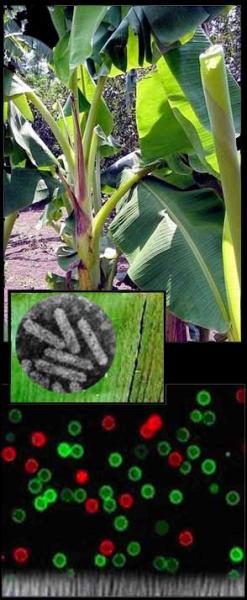biosecurity
Plant Biosecurity Cooperative Research Centre
An enhanced protocol for the quarantine detection of Tilletia indica and economic comparison with its current standard
| Publication Type | Journal Article | |
| Year of Publication | 2010 | |
| Authors | Tan, M.K; Brennan, J.; Wright, D.; Murray, G. | |
| Journal Title | Australasian Plant Pathology | |
| Volume | 39 | |
| Issue | 4 | |
| Pages | 334-342 | |
| Journal Date | 04/2010 |
This project aims to provide a better community awareness of and engagement in citrus biosecurity management.
What is the biosecurity problem?
Citrus is an important crop for both large scale industries in developed countries and for small farmers in many developing countries. Successful citrus biosecurity management, especially against citrus greening or huanglongbing (HLB) which is currently regarded as the most destructive diseases in citrus, is therefore dependant on the engagement of the entire stakeholders, including local communities and governments.
Regardless of the advance in technology now available for pest and disease management, the
citrus biosecurity will continue to be vulnerable if local governments and communities do not have a common understanding and closely work together.
The main outputs of this project are to:
- identify policy and community issues regarding citrus biosecurity in the region
- determine factors involved in policy delivery by local governments and local community engagement in biosecurity management in the region
- provide new policy directions derived from the capacity based approach to citrus biosecurity management in the region, and
- produce a PhD graduate with expertise in community management of citrus biosecurity.
Who will be the end-users of your research?
The outcomes of this project will assist local governments and communities in developing a better approach to citrus biosecurity management in particular however, it will also assist biosecurity management in general.

Wayan conducting in-depth interviews with one
of the village heads

Wayan having discussion with farmers in their field

HLB Symptom: Yellowing from the base of fruits
STUDENT
PROJECT DETAILS
Active
Supervisor
Professor Ian Falk, Ms Ruth Wallace, and Dr Bronwyn Myers (CDU) and Mr Lachlan Dobson (OrdGuard)
Supervising Institution
Charles Darwin University
Term
August 2008 - August 2011
LOCATION
This project will use individual-based modelling to investigate how genetic, biological, ecological and management factors interact to affect the evolution of resistance to the grain fumigant phosphine in the stored-grain pest, the lesser grain borer. This information will help identify optimal management strategies for delaying or avoiding the evolution of resistance.
What is the biosecurity problem?
The evolution of resistance to phosphine in the lesser grain borer.
The main output of this project is to:
- create simulation and statistical models of the population dynamics of Rhyzopertha dominica (lesser grain borer) that will incorporate evolution of resistance to phosphine. These models will be used to evaluate monitoring strategies and management programs to avoid, delay or minimise the evolution of resistance.
Who will be the end-users of this research?
Scientific researchers and agriculture biosecurity policy makers. Public and private extension officers, agronomists and farmers will be indirect end-users through resulting recommendations.
STUDENT

Dr Mingren Shi
Student CRC60128: Modelling Grain Borer - PhD
shim02@student.uwa.edu.au
Phone: 08 6488 1992
Read More
PROJECT DETAILS
Active
Supervisor
Dr Michael Renton (UWA), Mr Robert Emery (DAFWA), Professor James Ridsdill-Smith (UWA/CRCNPB) and (Associate Professor Yonglin Ren (Murdoch/CRCNPB)
Supervising Institution
University of Western Australia
Term
April 2009 - April 2012
LOCATION
This project will trace all the costs included in transporting grains from farms to the Kwinana region. This will be done through a mathematical model that will also include the possibility of emergence of phosphine resistance through out the grains’ journey.
What is the biosecurity problem?
Emergence of phosphine resistance during transporting or storing of grains.
The main outputs of this project are to:
- evaluate a new-built surveillance program developed to improve market access for biosecurity research
- improve industrial decisions based on a new complete surveillance program, and
- improve Australia’s biosecurity outcomes as a result of a complete surveillance program that could be used to lower the losses result from pest attack.
Who will be the end-users of this research?
Research field, industry, farmers and Western Australia (in terms of increasing its exports).
STUDENT
Mrs Hoda Abougamos
Student CRC60131: Economic Analysis of Surveillance - PhD
hoda.ragab@gmail.com
Phone: 0864884633
Read More
PROJECT DETAILS
Active
Supervisor
Dr Ben White (University of Western Australia) and Dr Ern Kostas (Co-operative Bulk Handling Limited)
Supervising Institution
University of Western Australia
Term
January 2009 - December 2011
LOCATION
This project developed advanced molecular diagnostic methods and immunological tools for the detection of plant viruses, which can be expediently applied in both post entry quarantine (PEQ) (import) and market access (export) context. Generic tests that are cost effective and reliable for plant virus detection will help reduce biosecurity risks from importations of plant material to Australia and New Zealand.
Research outcomes
In phase I of this project the project team:
- conducted a review of the importation processes of cereals into Australia and New Zealand
- designed and validated molecular tests that target groups of plant viruses that pose a threat to the grains industry, and
- investigated the application of the Flinders Technology Associates (FTA) card technologies for rapid and safe collection of plant virus samples, as well as storage of viral ribonucleic acid (RNA).
Research implications
This project has identified some areas for improvement for the importation of winter cereals into Australia. A superior diagnostic tool for the detection of potyviruses, the largest plant virus genus, has been developed and validated. A further four plant virus genus-specific tests have been designed and are currently being validated.
Importantly, this project has generated a foundation base for the design, development and validation of quality ready-to-go diagnostic tools to be used by quarantine pathologists. Strategies for the safe transportation of positive controls have also been initiated as a result of this project.
Acknowledgements
The project team would like to acknowledge the following collaborators for their support in project development and continued support for PEQ Phase II (CRC40135):
- Angela Freeman (Victoria Department of Primary Industries)
- John Thomas (Queensland Department of Primary Industries)
- Mark Gibbs (Australian National University)
- Mark Whattam (Australian Quarantine and Inspection Service)
- Kevin Davis (Biosecurity Australia)
- Karen Armstrong (Lincoln University, NZ)
- David Eagling (Cooperative Research Centre for National Plant Biosecurity)
PROJECT LEADER

Dr Brendan Rodoni
Project Leader CRC40050: Post Entry Quarantine (phase one)
brendan.rodoni@dpi.vic.gov.au
Phone: 03 9210 9264
Fax: 03 9800 3521
Read More
PROJECT DETAILS
Complete
Term
January 2008 – June 2009
Budget
$743,721 (cash and in-kind support)
PROGRAM DETAILS
CORE CRC PARTICIPANTS
The major aim of this research is to develop a multiplexed nanosensor assay for known viral pathogens of banana. The project will investigate the potential of a recombinant antibody array to detect virus particles. It is hoped that great efficiencies in virus diagnostics could be achieved if all assays could be done simultaneously using a single diagnostic platform.
What is the biosecurity problem?
Bananas are considered the most important fruit crop in developing countries and are the world's most exported fresh fruit in terms of volume and value. By world standards, Australia is a relatively small producer of bananas, however over 20.4 million thirteen kilogram cartons of bananas with an estimated wholesale value of AU$320,350 million are grown per annum, making it one of the most lucrative of the country's horticultural industries.
Cavendish, the mainstay of the Australian banana industry is susceptible to at least twenty different virus species, including Banana bunchy top virus (BBTV), Abacá bunchy top virus, Banana bract mosaic virus, the Abacá strain of Sugarcane mosaic virus (SCMV), Cucumber mosaic virus (CCMV) and upwards of fifteen different badnaviruses, any of which could devastate the industry if introduced.
Although good diagnostic assays are available for some of the banana viruses such as CMV, BBTV and SCMV detection of the badnaviruses causing banana streak disease is still very problematic. This is due to their great sequence diversity and also the integration of some badnavirus species DNA of in the genome of the banana plant. Standard polymerase chain reaction diagnostics using nucleic acid as a template are incapable of discriminating integrated from episomal (actively replicating) badnavirus DNA and therefore cannot be used for routine virus indexing work as part of clean planting material schemes.
The outputs of this project are to:
- contribute to a better understanding of virus particle structure and the distribution and variability of epitopes, leading to more robust serological techniques
- provide new, cheaper antibody array technologies with better orientation of antibodies on the solid phase and less non-specific binding of proteins
- provide a model system for the use of nanosensors to detect all types of protein markers, not only those associated with plant viruses but also animal viruses and even cancers, and
- train a PhD graduate trained in molecular detection technologies for plant pathogens.
Who will be the end-users of your research?
- Australian Quarantine and Inspection Service
- State and Territory Department of Primary Industries
- Australian banana industry
- Diagnostic laboratories, and
- Nanomics BioSystems Pty Ltd.

STUDENT
PROJECT DETAILS
Active
Supervisor
Dr Andrew Geering (QDPI&F), Dr Bronwyn Battersby (AIBN- UQ), Dr Hans Heines (CSIRO) and Dr Paul Campell (QDPI&F)
Supervising Institution
University of Queensland
Term
May 2008 – May 2011
LOCATION
This project developed an understanding of how the pathosystems may operate in Australia and determined what action to take, should either or both of the pest organisms arrive in the country. The knowledge gained will be used to make scientific and advisory recommendations in order to increase Australia's ability to deal promptly and appropriately with an incursion of either organism.
What is the biosecurity problem?
The bacterium Xylella fastidiosa is likely to be an emergency plant pathogen incursion in Australia in the future. The pathogen is part of an economically devastating pathosystem involving the vector insect Homalodisca vitripennis, the glassy-winged sharpshooter. The bacterium is associated with many diseases including Pierce's disease in grapevines. The pathogen is widespread in America and is spreading to other areas of the globe. The geographic distribution of the pathogen in the Pacific Islands is currently unknown although the insect vector has spread to Easter Island, French Polynesia, Hawaii and the Cook Islands and is clearly capable of relocating long distances across the Pacific.
The project investigated how X. fastidiosa and H.vitripennis will behave under Australian conditions. In particular, the potential interactions between native Australian flora and fauna and the two pest species was be explored. It is critical to develop a greater understanding of the system as it would operate in Australia in order to minimise the economic impact of either species arriving. The pathosystem is a threat to a wide range of horticultural crops, and could have severe detrimental impacts for Australia's primary production.
The main outputs of this project were to:
- establish the potential Australian native host plant range of H. vitripennis
- establish the potential Australian native host plant range of X. fastidiosa
- identify the native insect species currently established in Australia that have the ability to vector the pathogen
- quantify the extent of symptomless X. fastidiosa infections currently in Australia, if any, and
- prepare scientific and advisory recommendations that will enhance Australia's capacity to deal promptly and appropriately with an incursion.
Who are the end-users of your research?
AQIS, the government and the nursery and horticultural industries benefit from the advisory outputs.
STUDENT
PROJECT DETAILS
Complete
Supervisor
Dr Leigh Pilkington (NSW DPI) and Professor Geoff Gurr (CSU)
Supervising Institution
Charles Sturt University
Term
February 2009 – February 2012
LOCATION
Award for farm biosecurity

The 2009 Australian Rural & Outback Awards was launched last Thursday in Canberra. This is the inaugural year for the Australian Rural & Outback Awards, developed to recognise the incredible achievements of people and their communities across rural and remote Australia.





